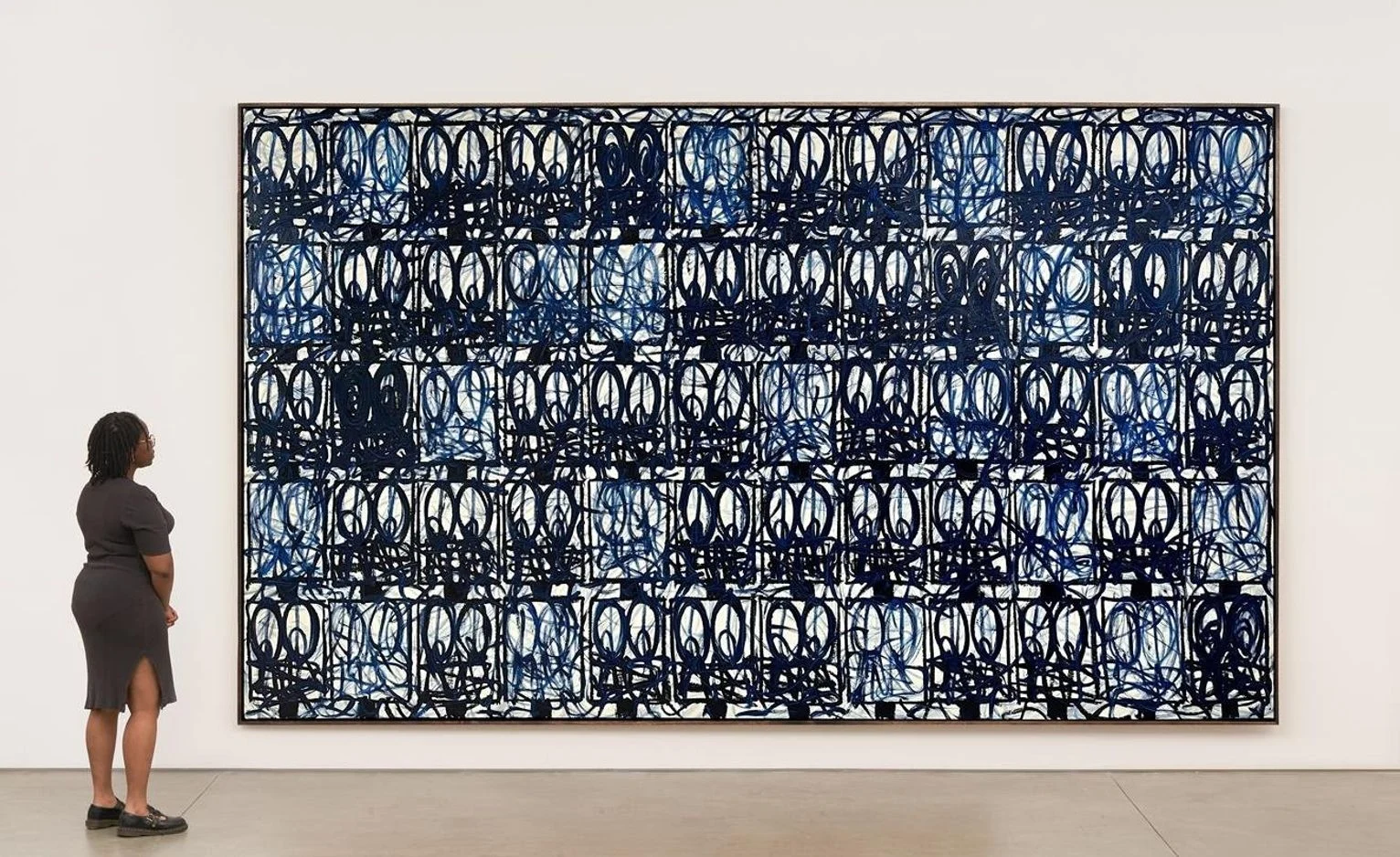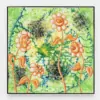Rashid Johnson: Black and Blue
18 September–30 October 2021
David Kordansky Gallery
5130 W. Edgewoord Pl.
Los Angeles, CA 90019
USA
David Kordansky Gallery is pleased to present Black and Blue, a major exhibition by Rashid Johnson featuring new bodies of work, including paintings, bronze sculptures, works on paper, and the debut of a new 35mm film. Occupying all three of the gallery’s exhibition spaces, Black and Blue will be on view September 18–October 30, 2021.
Since the beginning of his career, Johnson has pursued formal innovation in a diverse range of mediums while simultaneously honing a sophisticated and deeply personal vision on a variety of themes such as his autobiography, social history, philosophy, and art history. He addresses the existential conditions of his own life and life itself by making works born of both critical insight and free-form material exploration.

In Black and Blue, a group of new canvases that Johnson has titled ‘Bruise Paintings’ represent a further development of themes present in his ‘Anxious Red Paintings.’ Made during the pandemic, the ‘Anxious Red Paintings’ embodied the anxiety, isolation, and loss felt by many over the last two years. The ‘Bruise Paintings’ fill the entirety of the North Gallery and are rendered in deep blue oil paint; the colour is spread and layered across the oil-coated linen surfaces so that it takes on a range of blues, from light blue to almost black. The paintings conjure the feelings of aftermath, reckoning, and healing, with half-geometric, half-human faces arranged in expressive, viscous fields of line and colour.
They also constitute one of several components of the show that draw upon the mood and lyrics of the Fats Waller jazz standard ‘Black and Blue.’ Made popular in a key recording by Louis Armstrong, the song also plays an important role in Ralph Ellison’s novel Invisible Man. If the paintings are, on the one hand, indicative of the immediate impacts of violent societal change, on the other, they register a perennial state of affairs, and carry with them a surprising combination of shock, resignation, uncertainty, and poetry.
The South Gallery will be dedicated to Johnson’s latest engagements in bronze sculpture. Totems of head-like forms that resemble the characters in his paintings, these works also function as planters and include living plants that assert their own organic, ever-changing formalism. Their surfaces are covered with frenetic, palpably emotional mark-making that brings them into further relation with two-dimensional disciplines like drawing and painting. Like many of the different types of work that constitute his practice, they include diverse materials and objects—among them, records and oyster shells—that Johnson brings together to conjure their forms into being. These signifiers of leisure are evocative of ordinary, even banal pleasures, as well as of the images and ideas in Zora Neale Hurston’s essay, ‘How It Feels to be Colored Me’—another text that provides a conceptual framework for the show.
The contrast between the existential and the mundane is a driving force in the new film on view, also titled Black and Blue, which will be projected in the West Gallery. Shot in 35mm, Black and Blue depicts the movements of the protagonist—played by Johnson himself—as he navigates his daily routine. Eating, driving, exercising, spending time with family, and sleeping make up a life, and yet they are precisely the activities that get overlooked when epochal shifts are analysed and commemorated. The film is suffused with claustrophobia and isolation, though what is being witnessed has a complete lack of conflict or tragedy. A persistent melancholia inhabits each of the film’s segments; Johnson returns the gaze to the intimate endeavours of being human, which people do their best to sustain regardless of what is happening in the world at large.
Woven throughout the film are sounds and images that reveal their close connection to Johnson’s other works, both the new work in the current exhibition and from throughout his career. Photography books, novels, African sculptures, oyster shells, and branded wood—which have all appeared in the artist’s oeuvre—are incorporated into the film, either in the character’s environment or in brief flashes that move with the intuitive fluidity of thoughts and dreams. But so do atmospheric passages that are—like many of the guiding spirits in his project—abstract, open-ended, and evocative of natural worlds as much as cultural ones.
Installed alongside the film in the West Gallery are a group of works on paper in which Johnson demonstrates how his vocabulary pivots between the abstract, the representational, and the conceptual, challenging the notion that these can be understood as separate categories. Their bristling fields of repeated marks have roots in non-objective minimalism and observed forms alike; accordingly, they are vehicles for both internally and externally oriented modes of awareness.
Across the various environments that make up the exhibition, Johnson establishes a continuum in which visceral, unmediated, or ungovernable expressions and aesthetic proposals co-exist with recognisable artefacts and honed visual and verbal languages. The result is a rich and provocative portrait of a moment in time—one that also serves as a self-portrait, a commentary, and an invitation: as has been the case since the beginning of his career, even Johnson’s most pointed examples of self-examination are open, generous documents that brim with possibility and metaphor.
In addition to his September solo exhibition at David Kordansky Gallery in Los Angeles, Rashid Johnson (b. 1977, Chicago) will present large-scale artworks commissioned by the Metropolitan Opera which will be on view at the opera house during the 2021–2022 season. A major outdoor sculpture by Johnson was recently installed at Storm King Art Center, New Windsor, New York, and Stage, the artist’s interactive installation and sound work, is open through fall 2021 at MoMA PS1 in Queens, New York. Johnson has been the subject of solo exhibitions at Museo Tamayo, Mexico City (2019); Aspen Art Museum, Colorado (2019); Kemper Museum of Contemporary Art, Kansas City (2017), which travelled to the Milwaukee Art Museum (2017); McNay Art Museum, San Antonio, Texas (2017); Garage Museum of Contemporary Art, Moscow (2016); Galleria d’Arte Moderna e Contemporanea, Bergamo, Italy (2016); and Drawing Center, New York (2015). Notable group exhibitions include Grief and Grievance: Art and Mourning in America, New Museum, New York (2021); The Stomach and the Port, Liverpool Biennial, England (2021); Forever Now: Contemporary Painting in an Atemporal World, Museum of Modern Art, New York (2014); and ILLUMInations, International Pavilion, 54th Venice Biennale, Italy (2011).
His work is in the permanent collections of the Whitney Museum of American Art, New York; Guggenheim Museum, New York; Los Angeles County Museum of Art; and Museum of Contemporary Art Chicago. His first feature-length film, an adaptation of Richard Wright’s Native Son, premiered at the Sundance Film Festival and was released on HBO in 2019. Johnson lives and works in New York.
©2021 Rashid Johnson, David Kordansky Gallery, Martin Parsekian





